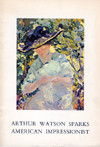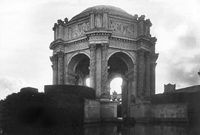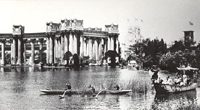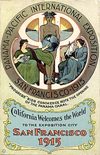The Westmoreland County Museum of Art (now the Westmoreland Museum of American Art) in Greensburg, Pennsylvania. December 7th, 1963 through January 21st, 1964.
This was the last showing of Sparks paintings that was organized by Frederick Robert Sullivan and Mary Lee Sullivan
(my grandparents). The director of the museum at that time was Paul A. Chew. He created an introduction for the museum catalog of Arthur's last show in 1964. The following is what he wrote.
While impressionism was a French development, it remained essentially a French style; however, there were national variations of the school which showed great originality and this is particularly true of American artists. The latter part of the nineteenth century first found American artists drawn to Munich and Dusseldorf, but by the turn of the century Paris had become the great magnet. The French School of impressionism and its impact on the world of art have been well documented but the American School of Impressionism has yet to be written. This first comprehensive exhibition of paintings by Arthur Watson Sparks will certainly add a page to that unwritten history.
Spark's early training was in the field of architecture and it was while working in an architect's office in Washington, DC at the close of the last century that we find him studying evenings at the Corcoran Art School and also in the studio of Howard Helmick. Shortly Sparks also became a monitor for the life class under the instruction of Eliphalet Andrews. There was a young Pittsburgher in this class by the name of Patrick J. Byrne who was to become an intimate friend of Sparks and was instrumental in the decision that was later to bring Sparks to Pittsburgh as the first professor of painting and illustration in the newly organized Carnegie Institute of Technology. In 1898 Sparks submitted a design for the proposed Hall of American Inventions for the Paris exhibition of 1900. Sparks's design won this competition and he was selected to accompany the United States Commission that was to install exhibitions in the American pavilion. The impact of the vital art world Sparks found in Paris led him to the decision to remain on in Paris after the exhibition opened. In order to pay for his art instruction at the Julian Academy, where he studied with Laurens, Sparks secured a job as a guard and later as a packer for several of the American exhibits. It is interesting to note that one of these exhibits was that of H.J. Heinz canned food products of Pittsburgh. In 1902 Sparks entered the Ecole des Beaux Arts where he studied for two years. Among his instructors at the Ecole des Beaux were Cormon and Bouguereau and during these student years he traveled with a number of class friends to Italy, Belgium, Spain, Morocco, and Algeria. Intermittently, from 1900 to 1904, Sparks took a studio in Paris and in the south of France a at Martigues. In his letters to his father and his sister one finds critical comments that are noteworthy references to the great Paris Salon exhibitions and to the sterility that he found in accepted masters of the time. However, with great sympathy he openly expressed his feelings about the new movement which we know today as impressionism, and it is in this direction that we find Sparks developing his style.During all these years abroad Sparks continued a correspondence with his friend P. J. Byrne. In 1908 when the Department of Painting and Illustration was ready to be organized at Carnegie Institute of Technology, Byrne went to the Institute director, A. A. Hammerschlag, and pleaded Sparks's cause for the new position. He thus became the professor and head of the new department that same year, remaining in the post until 1919. The College of Fine Arts building had not yet been completed and his classes were held in the School of Industry. It is fitting here to mention a number of Spark's students of those early years that have become notable artists: Wilfrid Readio, Malcolm Parcell, Vincent Nasbert, Raymond Simboli, Samuel Rosenberg and Russel Twiggs. Rosenberg, Simboli, Twiggs, and Jack Nash, who was then on the staff at the Carnegie Museum, all recall with fondness their memories of Sparks as a person of great warmth, kindness, and sincere devotion to the arts. Rosenberg mentioned that Spark's class numbered in fifteen of twenty students. He related that Sparks's method of teaching was fashioned after that of the Ecole des Beaux Arts. Students would begin their training by drawing from casts of ornaments, advancing to drawing of cast fragments, and finally to casts of figures. The ultimate reward of this disciplined training would be the stamp of approval by the instructor to be admitted into the life classes. It is of interest to note that life classes during these still Victorian days were separated; that is, one studio would be the male students with the model and in another studio the female students with their model. When Sparks first came to Pittsburgh he lived with the Byrne family and in 1909 he returned to Paris and married Mlle Clemence Perussit, whom he had met during the Paris Exposition where she worked as an interpreter and as a demonstrator for the underwood Typewriter Company. Upon returning to Pittsburgh the family took up residence on Beeler street. Sparks became an active member of the newly organized Associated Artists of Pittsburgh for whom he served on occasions as a juror. He was invited to exhibit in the Carnegie Internationals of 1912 and 1914 and also exhibited in such art centers as the National Academy of Design, New York, Pennsylvania Academy of the Fine Arts, Philadelphia, the Art Institute of Chicago, and the Corcoran Gallery of Washington, DC.
In 1918 Sparks made six large charcoal sketches that were to be installed as murals in the main hall of the College of the Fine Arts building where they can still be seen today. These murals, four by six feet each, were designed to embellish the architecture of the hall and they form a record of the progress of the work on the College of Fine Arts, School of Industry,Machinery Hall, the Science building, main hall of the art school, and a theater scene at rehearsal Sparks painted a number Pittsburgh scenes, several of which are in this exhibition. There is evidence by exhibition catalogs, newspaper articles, and letters of the period that there are many additional paintings of Pittsburgh that were unfortunately unable to be located, and it is hoped that as a result of this exhibition, sufficient interest in Spark's work might be aroused to rescue some of these lost paintings from oblivion. The records at the Carnegie Institute of Technology show that he was on the faculty through 1919 when he resigned but actually the last six months he was inactive as a teacher. The last months were spent painting in the vicinity of New Hope, Pennsylvania, with his artist-friend, Edward Redfield. Sparks died in august of 1919, a victim of the influenza epidemic.
This exhibition, which represents the span of his brief painting career from about 1906 to 1919, stands as a proof of the importance and significance of Sparks's work. It should be pointed out that inspite of his training in Paris under the great teachers of the academic tradition, his style developed from his love of the impressionist movement, and especially Monet, whom he mentioned often in his letters. So, Pittsburgh art was to gain a talent with the rare gift of absorbing the ideas of French Impressionism with the intuition and intelligence to weld them into a style that was Sparks's own. The gray-black and smoke-laden industrial Pittsburgh, its cityscape and landscapes were transposed through the eyes of this artist into brilliant color and light of French Impressionism. As a teacher and a friend of artists. Spark's vitality was always stimulating, and his advise to his students encouraged them to strike out on new paths where their own ability and integrity would be their strongest assets.This first one-man show exhibit of Arthur Watson Sparks, we hope, will demonstrate that he has a rightful place in the ranks of well-known American Impressionists such as Theodore Robinson, Childe Hassam, John H. Twachtman, and Maurice Prendergast.
The brief story that follows may be of interest to those wishing to learn how this exhibition came about. Mr. Norman Hirschl, of Hirschl & Adler Galleries in New York, who knows the Museum and who has repeatedly demonstrated generosity and interest in its growth, first approached me knowing that such an exhibition would be important, not only from the point of view of the quality of the work, but also because of its local implications.Through Mr. Hirschl's courtesy, I visited Mr. Frederic Ziv of Cincinnati, Ohio, a collector of masterworks of the French Impressionist School, who had lately been attracted to Sparks's work. Mr. Ziv's brother-in-law, Frederic R. Sullivan, was the artist's nephew, and he had at one time been given 50-odd paintings by Mme. Sparks, the widow of his uncle. It was an opportunity to make a real study of Spark's work, which aroused enthusiasm for this exhibition.
For the catalog Mr. Sullivan lent photographs, letters, and other documents that have been valuable in putting together the biography of the artist. I must also thank Mrs. Eleanor Byrne Vogel, of Pittsburgh, for her letters, photographs, and other documents belonging to her father, Patrick J. Byrne. Jack Nash, Samuel Rosenberg, and Raymond Simboli, all helped by sharing memories of their early teacher and friend.Paul A. Chew
Director of the Westmoreland County Museum of Art
Greensburg, Pennsylvania
1963.



